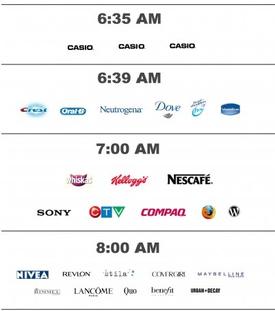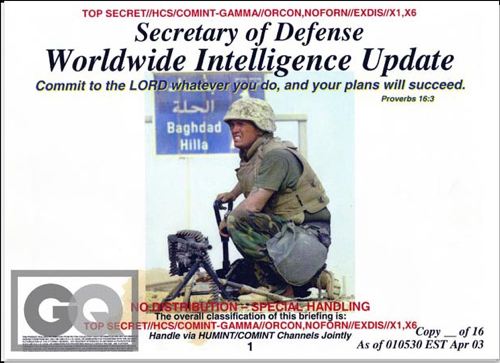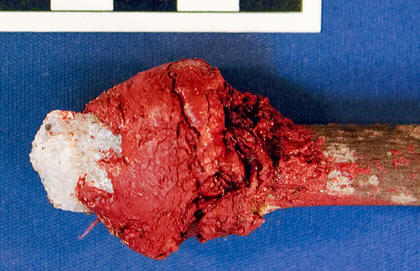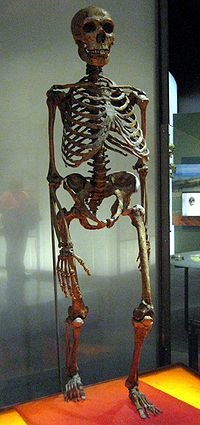The Latest from Boing Boing |  |
| Posted: 18 May 2009 11:18 PM PDT Aaron sez, "An engineer gutted an old Volkswagen that he bought on Craigslist and designed a custom electric motor for it. It can hit 82 MPH!" Tischer's EV project VW Owner Shifts Gears, Goes From Gas to Electric (Thanks, Aaron) |
| Crazy-ass freeway exchanges of the world Posted: 18 May 2009 10:12 PM PDT  Jebediah sez, "This is a photo gallery of strange and striking freeway interchange configurations, including ones like the volleyball, the double trumpet, and the turbine. Many are as, or more, visually interesting than the cloverleaf. Learning all the different varieties makes one feel a bit like a birdwatcher when driving on the interstate. 'Oh, there's a classic diamond! And there's a clovermill!'" What's A 'Spooey'? A Field Guide To Freeway Interchanges, Part 1 (Thanks, Jebediah!) |
| Posted: 19 May 2009 01:20 AM PDT Researchers at the University of the Witwatersrand in Johannesburg, South Africa have discovered a sophisticated stone-age "superglue" that was used to make and reinforce tools: Stone Age Superglue Found -- Hints at Unknown Smarts? (via Make) |
| HOWTO keep your parody site safe from legal bullies Posted: 18 May 2009 10:07 PM PDT Hugh sez, "The Electronic Frontier Foundation's Corynne McSherry has put together a great whitepaper with tips on how to avoid having your parody or gripe site shut down." Six Simple Steps You Can Take To Protect Your Gripe or Parody Site (Thanks, Hugh!) |
| Posted: 18 May 2009 10:04 PM PDT InfoWorld's Paul Venezia has proposed a pretty good "Technology Bill of Rights" encompassing DRM, neutrality, anonymity, liability for malware, liability for proprietary software, and open source for government. I think it's a great starting point, though some of the Slashdotters suggest modelling it on the US Bill of Rights and/or the Makers' Bill of Rights. Article 4. A company that produces and sells closed source software for use on computers shall be responsible for the security of that product, and a user has a right to seek damages in the event of a failure to secure their productTechnology Bill of Rights (via /.) |
| Brand timeline -- what brands do you interact with and when? Posted: 18 May 2009 10:00 PM PDT  Jane Sample and her blog-readers are composing "brand-timelines" that show which brands they interact with through the day... Mine would go phone, laptop, six zillion websites, diapers, milk, coffee, porridge, fruit, Dr Bronner's, stroller, then nothing until mid-afternoon (my reading time) when there'd be a publisher logo, then nothing until evening, then diapers, baby shampoo, a million websites, and nothing. Jane Sample and her blog-readers are composing "brand-timelines" that show which brands they interact with through the day... Mine would go phone, laptop, six zillion websites, diapers, milk, coffee, porridge, fruit, Dr Bronner's, stroller, then nothing until mid-afternoon (my reading time) when there'd be a publisher logo, then nothing until evening, then diapers, baby shampoo, a million websites, and nothing. |
| Chris Carter's tribute to the BBC Radiophonic Workshop Posted: 18 May 2009 08:55 PM PDT Throbbing Gristle's Chris Carter made a short video tribute to the BBC Radiophonic Workshop. Dig that pedal pandemonium! Ever since it was founded in 1958 to create sound effects and scores for radio programs, the BBC Radiophonic Workshop has been a huge influence on many electronic and experimental musicians. (via @chris_carter_) Previously: |
| BB Video - Guatemala Protests: Eyewitness Cellphone Video from Twitterers Posted: 18 May 2009 03:19 PM PDT This past Sunday in Guatemala, tens of thousands of people gathered in the capital city to protest the assassination of an attorney who blamed president Álvaro Colom for his imminent murder in a posthumously-released YouTube Video. Boing Boing Video viewer (and BB blog reader) Maria Figueroa (@thevenemousone on Twitter) was there with friends, and she sent us this eyewitness report captured on her cellphone. The video featured here was shot on Maria's phone just as the protest was assembling. Her photos from Sunday's protest are here on Flickr. Here are more video clips documenting the protests. Previously:
|
| BB Video - Miles O'Brien Reports: An Astronaut Climbs Everest Posted: 18 May 2009 02:21 PM PDT (Download MP4 / Watch on YouTube) In this episode of Boing Boing Video, guest contributor Miles O'Brien, the veteran space and science reporter formerly with CNN, speaks with astronaut Scott Parazynski as he attempts to summit Mt. Everest. Parazynski and his team are scheduled to actually attempt the summit within the next day or two, as I understand their current plans. More of Miles "1337" O'Brien's work at True/Slant, and you can (and should) follow him here on Twitter. Astronaut-turned-climber Scott Parazynski's Everest climb blog is here, and you can also follow him on Twitter, live from Nepal. Below, a screengrab of their current coordinates -- and a snapshot of Scott at rest on Mount Everest. After the jump, more photos. (Previously: Boing Boing Video: Welcome, Miles O'Brien!) |
| Atomic Disruptor Raygun: steampunk gun made from radios and cameras Posted: 18 May 2009 01:47 PM PDT Here's a sweet steampunk raygun, homebrewed from camera and radio parts: Make a Steampunk "Atomic Disruptor" Raygun from Old Parts (via Make) |
| Posted: 18 May 2009 01:47 PM PDT (Rudy Rucker is a guestblogger. His latest novel, Hylozoic, describes a postsingular world in which everything is alive.)
What's up with so many young people shaving their heads bald? The thing is, if you're at all overweight, you're going to have a lipless slit-mouth wrinkle on your nape. So your back is like an eyeless alien face.
Not to be dissing these guys, but what's wrong with a nice modest fringe of hair like balding guys used to have? And why does everyone wear their sunglasses on the top of their head these days, even at night, even in the movies? I expected more from the 21st Century. The Urban Dictionary has some gnarly slang entries relating to neck rolls. And some guy wrote a choleric song on his blog about a guy with a shaved head talking on his cell phone, "Loud Bald Fat Man on the Metro" .
You scream at your boss through your cell |
| Town bans hoods, hats, shades in banks Posted: 18 May 2009 01:25 PM PDT Frank sez, "I know you're asking for trouble wearing a ski mask inside a bank. Now, my town [Ed: Westerville, OH] is prohibiting wearing hats, hoodies, sun glasses and also the use of cell phones inside banks. When will the insanity end?" Westerville police have asked the city's 21 banks and credit unions to post window signs that direct customers to put away cell phones and remove sunglasses, hoods and hats.No hat, no hood, no shades? Come on in (Thanks, Frank) |
| Boing Boing Video: Welcome, Miles O'Brien! Posted: 18 May 2009 02:50 PM PDT  Just as we invite guestbloggers to the Boing Boing blog, we periodically welcome guest correspondents to Boing Boing Video, our daily online video program. I am thrilled to announce today that we have the honor of welcoming none other than Miles O'Brien, former CNN anchor and reporter, one of the most esteemed space and science journalists on the home planet, as a Boing Boing Video guest contributor. Snip from his bio: "Miles is a 26-year broadcast news veteran - with nearly 17 years as CNN's science, aerospace, technology and environment correspondent. He is now on his own - based in New York City - covering the same stuff across various media platforms."Since departing CNN, Miles has been doing really interesting experiments in online media, including webcasts, features over at True Slant, live-twittering Space Shuttle launches, and other work we hope to showcase here on BB soon. I've been watching him explore what is possible in online, independent news venues with the same sense of adventure that captivated me in his space reporting for CNN. The video he's been producing as a solo journalist is wonderful. Miles is a personal hero. He's the best there is at what he does. It is with the absolute deepest respect that we welcome him as a guest colleague. |
| Web Zen: Talk Like a Pilot Zen Posted: 18 May 2009 12:18 PM PDT talk like a pilot day Permalink for this edition. Web Zen is created and curated by Frank Davis, and re-posted here on Boing Boing with his kind permission. Web Zen Home and Archives, Store, Twitter. (Thanks Frank!) |
| BB Video: Recent Episodes, For Your Viewing Pleasure. Posted: 18 May 2009 12:15 PM PDT Recently on Boing Boing Video... * "TO." An ambient animated short by filmmaker Bob Jaroc and the band Plaid (Warp Records). Best enjoyed with stereophonic supersonic headphones, so you can appreciate the shift from one channel to another, while you watch thousands of starlings take flight in a burnt sunset sky. (DOWNLOAD / YOUTUBE) * "SEBASTIAN'S VOODOO." We revisit a beautiful animated work by UCLA student Joaquin Baldwin, which we first featured on our daily video program about a year ago. It's up for an award at Cannes! Vote for it! (DOWNLOAD) "$5 COVER." Director Craig Brewer (Hustle and Flow , Black Snake Moan) talks to us about his latest project: the MTV online series $5 Cover, which chronicles the internet-age lives and dreams of struggling musicians in Memphis, Tennessee. (DOWNLOAD / YOUTUBE) RSS feed for new episodes here, YouTube channel here, subscribe on iTunes here. Get Twitter updates every time there's a new ep by following @boingboingvideo, and here are blog post archives for Boing Boing Video. (Special thanks to Boing Boing's video hosting partner Episodic). |
| Donald Rumsfeld's Strangeloveian Defense Briefing Art Posted: 18 May 2009 12:07 PM PDT  Over at Gawker, Foster writes: [A]longside Robert Draper's GQ piece on Donald Rumsfeld being called out by former colleagues, they're running covers of his White House morning defense briefings. You have to see these.Donald Rumsfeld's Judgment-Happy, Scary, Biblical Defense Briefing Art (Gawker, thanks Richard Metzger) |
| Posted: 18 May 2009 02:19 PM PDT  Sorry about that. Image by Origami Roman, something Deckard would have liked. (Thanks, Susannah Breslin) |
| Posted: 18 May 2009 11:50 AM PDT  Here's my first cigar box guitar. The frets are crooked, the action is too high (because I forgot that I needed to shave off the part of the neck that's glued to the box), the sound hole cuts into the neck, the neck is split, I shouldn't have used pine for the neck because it will bow, the fret dots aren't centered. And yet it works! I have already started making CBG #2. If you are interested in making one of your own, I recommend Bill Jehle's excellent DVD: How to Build a Guitar: the String Stick Box Method, and joining Cigar Box Nation, a social network of cigar box guitar makers. |
| Father, High on PCP, Eats Son's Eyeballs Out Posted: 18 May 2009 02:19 PM PDT A man in Bakersfield, California got high on PCP and ate his son's eyeballs out. Then the father attempted to hack his own legs off with an axe. The boy's mother, also a PCP user, came to the door just before the attack to deliver a pizza to their home, heard her son screaming for her to rescue him, but left anyway. We don't have a metadata tag that fits this story. It's been haunting me for days since I read it, even in dreams, which is why I'm finally blogging it now. Does PCP turn people into monsters, or do monsters simply turn to PCP? I can't figure it out. My god, that poor child. (Thanks, Chief Fulfiller of Needs) |
| Alice in Wonderland, Remixed: "Smokin' on the Dro," by Three Six Mafia Posted: 18 May 2009 11:23 AM PDT A wonderful remix produced by Lindsay, aka waambat, who studies electronic media at the University of South Florida. She did an equally awesome Muppet remix of Peaches' "Fuck the Pain Away." (Thanks, Susannah Breslin!) |
| What Became of Neanderthals? We Ate 'em, Made 'em into Jewelry, Says Scientist Posted: 18 May 2009 11:05 AM PDT A French fossil expert believes he's solved one of the great mysteries of science -- the question of why Neanderthals disappeared. His theory? Humans ate them. How Neanderthals met a grisly fate: devoured by humans (Guardian UK, photo via Wikipedia) |
| Posted: 18 May 2009 11:17 AM PDT  I know nothing about the Internet Identity Workshop 2009 except that their logo made me laugh aloud. I know nothing about the Internet Identity Workshop 2009 except that their logo made me laugh aloud. |
| 1939 World's Fair Chrysler 3D movie Posted: 18 May 2009 10:50 AM PDT Our pal Iowahawk went to a swap meet and picked up a pair of 3D glasses from the 1939 World's Fair. They were given out to attendees so they could watch Chrysler's whimsical stop motion movie (above) that shows a car being assembled by invisible workers. The glasses prompted Iowahawk to do a little digging into Chrysler's exhibition at the World's Fair, and he found a number of interesting images, which he shares on his blog. What a show it must have been -- a Rocket Port of Tomorrow, a Talking Car, a Frozen Forest, all manner of Engineering Wonders, plus the aforementioned 3-D movie extraganza. Still something strikes me in this ephemera as very melacholy. In 1939 The US was going through a 10th straight year of economic depression (national unemployment was still 17%) and by September, WWII was underway; a stark contrast with the shiny optimism reflected these (kinda) rose colored glass. If any car company in 1939 had reason to be skittish about futurism it was Chrysler, which had recently taken a major financial bath on the too-far-ahead-of-its-time Airflow; and yet they seem pretty bullish on the whole thing here. It's hard to imagine this kind of optimisitic boosterism at Chrysler today. Belvidere itself home to a half-empty Chrysler assembly plant, which I passed on the way to the swap meet. Whether Chrysler can survive as a zombie mutant financial partnership between the Federal government and Italian industrialists, it certainly won't share DNA with the company who staged this production.1939 World's Fair Chrysler 3D movie |
| MAKE magazine projects as free PDFs Posted: 18 May 2009 10:28 AM PDT    MAKE magazine is giving away PDFs of the projects I demoed on The Martha Stewart Show today. Grab 'em while they're hot! |
| Posted: 18 May 2009 09:21 AM PDT  Rudy woke up earlier than I did this morning, so he started blogging before I had a chance to introduce him! I met Rudy Rucker around 1987 when he gave a reading at a High Frontiers Monthly Forum meeting in Berkeley, California. Rudy read from his novel Wetware and brought along an unfolded tesseract that he'd made from cardboard and tape. I told him that his 1984 novel, Master of Space and Time, reminded me a little of Fredric Brown's The Mind Thing, he said that was an interesting observation. We've stayed in touch over the years, and he has contributed to a number of projects I've been involved with, including Wired, HardWired, bOING bOING, and Boing Boing. (His daughter Georgia designed The Happy Mutant Handbook, too!) As always, it's a thrill to again have Rudy contribute to Boing Boing. Here's his intro post: For me, Mark Frauenfelder has always been like a Good Elf, the kind that helps the needy woodcutter in the fairy tales. He’s reliably into whatever I’m up to, which is a rare joy. |
| WWII Stalingrad diorama photos Posted: 18 May 2009 08:52 AM PDT |
| Foro Internet Meeting Point in northern Spain (Asturias) Posted: 18 May 2009 11:32 AM PDT  I'm going to speak at Foro Internet Meeting Point in Asturias this June. Here's a brief interview. (Thanks, Miguel!) |
| Posted: 18 May 2009 08:21 AM PDT John Szwalla, 17, of Winston-Salem, North Carolina, attempted to rob an Internet cafe with a concealed banana he said was a gun. From the Associated Press: The owner, Bobby Ray Mabe, said he and a customer jumped Szwalla, holding him until deputies arrived. While they waited, Mabe says the teen ate the banana."Deputies: Banana used as gun in holdup, then eaten" |
| Posted: 18 May 2009 08:29 AM PDT  (Rudy Rucker is a guestblogger. His latest novel, Hylozoic, describes a postsingular world in which everything is alive.) I love gnarly shapes and processes---gnarly in the sense of being not too orderly and not too random, right on the living border. Moving water is amazing stuff, and cranking your camera's shutter speed up high lets you freeze it. And your foot, every now and then you look at it and---how strange. Really, we're as oddly shaped as any fabulous jungle plant or deep ocean crustacean. A few years ago, I gave a talk called "Seek the Gnarl" where I talked about how gnarliness relates to the way a writer creates the plot for a novel.
 I took this photo on Shattuck Avenue in Berkeley the other day. I like the contrast between the digital numbers labeling the billboard, and the gnarly tatters of the peeling paper. The numbers are the outline, the (actually quite elegant) shapes of the paper are the novel. I'm not saying a novel should be a random mess. I'm saying that it's nice if the story has the organic and unpredictable feel of some living thing that's grown or of some natural shape that's arisen over time. The characters and tropes and social situations bounce off each other like eddies in a turbulent wakes, like vines twisting around each other in a jungle, like the plates of a skull.
Online version of Rudy's talk, "Seek the Gnarl". |
| Debt-collectors and credit card companies: the psychologists of predatory lending Posted: 18 May 2009 07:30 AM PDT The NYT has an in-depth look at the pop-psych training that bill collectors are getting, using profile data sucked out of card histories to figure out how to get inside debtors' heads and get them to cough up money they can't afford. This is driven by the long-term strategy of offering cards to poor credit risks on the grounds that they'd be apt to get into debt and cough up huge amounts in interest payment, unlike well-heeled yuppies who pay every bill on time. The exploration into cardholders' minds hit a breakthrough in 2002, when J. P. Martin, a math-loving executive at Canadian Tire, decided to analyze almost every piece of information his company had collected from credit-card transactions the previous year. Canadian Tire's stores sold electronics, sporting equipment, kitchen supplies and automotive goods and issued a credit card that could be used almost anywhere. Martin could often see precisely what cardholders were purchasing, and he discovered that the brands we buy are the windows into our souls -- or at least into our willingness to make good on our debts. His data indicated, for instance, that people who bought cheap, generic automotive oil were much more likely to miss a credit-card payment than someone who got the expensive, name-brand stuff. People who bought carbon-monoxide monitors for their homes or those little felt pads that stop chair legs from scratching the floor almost never missed payments. Anyone who purchased a chrome-skull car accessory or a "Mega Thruster Exhaust System" was pretty likely to miss paying his bill eventually...What Does Your Credit-Card Company Know About You? |
| You are subscribed to email updates from Boing Boing To stop receiving these emails, you may unsubscribe now. | Email delivery powered by Google |
| Inbox too full? | |
| If you prefer to unsubscribe via postal mail, write to: Boing Boing, c/o Google, 20 W Kinzie, Chicago IL USA 60610 | |




















No comments:
Post a Comment